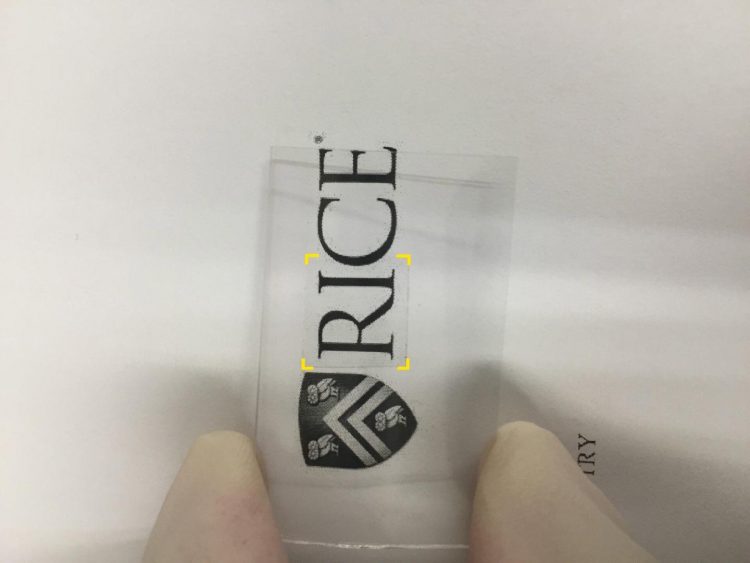'Rivet graphene' proves its mettle

Rivet graphene (outlined in yellow) is nearly as transparent as pure graphene and retains its strength and conductivity even when flexed. The material was created at Rice University. Credit: Tour Group/Rice University
Nanoscale “rivets” give graphene qualities that may speed the wonder material's adoption in products like flexible, transparent electronics, according to researchers at Rice University.
The Rice lab of chemist James Tour reported the creation of “rivet graphene,” two-dimensional carbon that incorporates carbon nanotubes for strength and carbon spheres that encase iron nanoparticles, which enhance both the material's portability and its electronic properties.
The material is the subject of a paper in the American Chemical Society journal ACS Nano.
Until now, researchers have had to transfer graphene grown via chemical vapor deposition with a polymer layer to keep it from wrinkling or ripping. But the polymer tended to leave contaminants behind and degrade graphene's abilities to carry a current.
“Rivet graphene proved tough enough to eliminate the intermediate polymer step,” Tour said. “Also, the rivets make interfacing with electrodes far better compared with normal graphene's interface, since the junctions are more electrically efficient.
“Finally, the nanotubes give the graphene an overall higher conductivity. So if you want to use graphene in electronic devices, this is an all-around superior material,” he said.
Tests proved rivet graphene retained the strength of the Tour lab's rebar graphene (which incorporates nanotube reinforcement) as well as rebar's ability to float on water. But the rivets also enhanced the material's ability to transfer current between electrodes and the graphene, even when bent, the researchers reported.
The rivets are layers of carbon wrapped around a 30-nanometer iron core, dubbed “nano-onions” by the lab. The structures are grown in place in the CVD furnace after the dispersal of nanotubes and deposition of graphene. A final step welds all the elements together, Tour said.
Rivet graphene is transparent enough for flexible and transparent electronics, he said, and the simplified process should be scalable.
###
Xinlu Li, a former visiting researcher at Rice and a professor at Chongqing University, China, is lead author of the paper. Co-authors are graduate student Junwei Sha of Rice, Tianjin University, China, and the Collaborative Innovation Center of Chemical Science and Engineering in Tianjin; graduate student Yilun Li, postdoctoral researcher Yongsung Ji and former postdoctoral researcher Seoung-Ki Lee of Rice; and Yujie Zhao of Chongqing. Tour is the T.T. and W.F. Chao Professor of Chemistry as well as a professor of computer science and of materials science and nanoengineering.
The research was funded by the Air Force Office of Scientific Research and its Multidisciplinary University Research Initiative, the Natural Science Foundation Project of China's Chongqing Science and Technology Commission and the China Scholarship Council.
Read the abstract at http://pubs.
This news release can be found online at http://news.
Follow Rice News and Media Relations via Twitter @RiceUNews
Related materials:
Tour Group: http://www.
Wiess School of Natural Sciences: http://natsci.
Located on a 300-acre forested campus in Houston, Rice University is consistently ranked among the nation's top 20 universities by U.S. News & World Report. Rice has highly respected schools of Architecture, Business, Continuing Studies, Engineering, Humanities, Music, Natural Sciences and Social Sciences and is home to the Baker Institute for Public Policy. With 3,910 undergraduates and 2,809 graduate students, Rice's undergraduate student-to-faculty ratio is 6-to-1. Its residential college system builds close-knit communities and lifelong friendships, just one reason why Rice is ranked No. 1 for best quality of life and for lots of race/class interaction by the Princeton Review. Rice is also rated as a best value among private universities by Kiplinger's Personal Finance. To read “What they're saying about Rice,” go to http://tinyurl.
Media Contact
All latest news from the category: Materials Sciences
Materials management deals with the research, development, manufacturing and processing of raw and industrial materials. Key aspects here are biological and medical issues, which play an increasingly important role in this field.
innovations-report offers in-depth articles related to the development and application of materials and the structure and properties of new materials.
Newest articles

NASA: Mystery of life’s handedness deepens
The mystery of why life uses molecules with specific orientations has deepened with a NASA-funded discovery that RNA — a key molecule thought to have potentially held the instructions for…

What are the effects of historic lithium mining on water quality?
Study reveals low levels of common contaminants but high levels of other elements in waters associated with an abandoned lithium mine. Lithium ore and mining waste from a historic lithium…

Quantum-inspired design boosts efficiency of heat-to-electricity conversion
Rice engineers take unconventional route to improving thermophotovoltaic systems. Researchers at Rice University have found a new way to improve a key element of thermophotovoltaic (TPV) systems, which convert heat…



